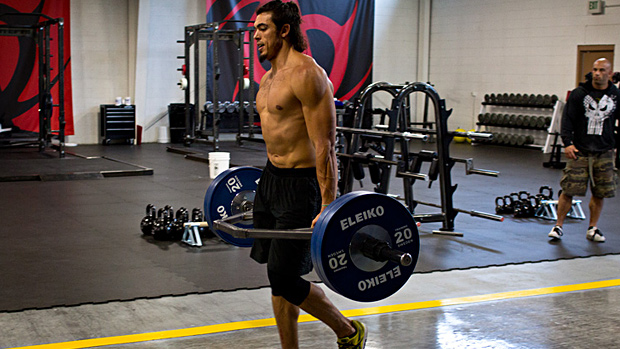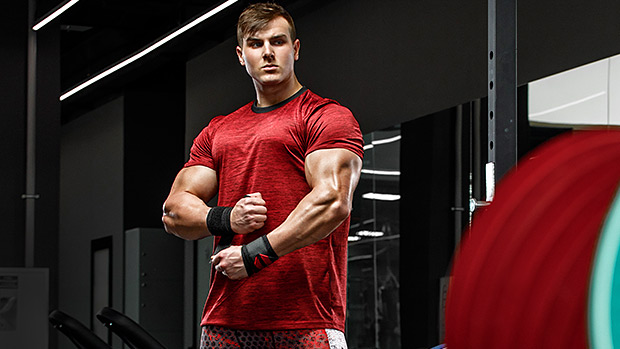There comes a point when every lifter hits a plateau, but getting past it doesn't always require major changes. Sometimes all it takes is a subtle tweak or two. Small hinges swing big doors.
That's where these add-ins come in. They take hardly any time to do, yet they’ll help you get bigger, stronger, and more resilient – without interfering with your regular training.
Time: 5 Minutes
If your warm-up consists of nothing more than a light set or two before you start your big lift of the day, it's only a matter of time until your joints start to get angry.
The solution: Pick two exercises – one high-velocity movement and one movement to prime your posterior chain – and alternate between them for five minutes. The goal is to accumulate as many good reps as possible without accruing much fatigue.
How To Do It
Pick exercises based on your primary lift of the day. The power-based movement should mimic the main lift's movement pattern. The primer should target the glutes and hamstrings prior to squatting/hinging, or the upper back prior to pressing. Examples:
- Lower Body Power: Box jumps, broad jumps, sprints, kettlebell swings
- Upper Body Power: Medicine ball throws, medicine ball chest passes, plyo push-ups
- Lower Body Primers: Glute bridges, band pull-throughs (see video below), stability ball leg curls
- Upper Body Primers: Face pulls, band pull-aparts, YTWs
In terms of volume, stay at the lower end of the spectrum for the power movement – between 3-5 reps is plenty – to avoid getting fatigued. Conversely, feel free to ramp up the reps on the primer. A slight pump in the posterior chain can enhance performance due to the increased involvement of the stabilizing musculature.
Here's why power-primer supersets are so valuable:
- High-velocity movements fire up the CNS to tap into a heightened state, which translates to stronger lifts and more efficient movement under load.
- The high-threshold motor units recruited through fast concentric actions have the most potential for muscle growth, which means more muscle can be recruited while training.
- Power drops almost twice as fast as strength with age (if left untrained), which, seeing as power is highly correlated with all-cause mortality, makes it important to maintain.
The benefits of the primer are more straightforward, but the premise is that activating the commonly inactive muscles of the posterior chain prior to training will facilitate better positions and smoother sequencing on subsequent lifts.
Plus, high-rep posterior chain work is a good way to battle back against the caveman posture and gluteal amnesia caused by sitting.

Time: None (Sort Of)
Fillers are low-level mobility, stability, or activation drills you can plug in between sets of a heavy strength or power exercise. Their purpose is to make the most out of rest periods while targeting weak links, addressing mobility deficiencies, and/or working on stability issues that might manifest while training.
How To Do It
The key is to choose low-level fillers that aren't strenuous enough to interfere with the primary exercise. Choose the best option for your needs. If you have poor motor control or hypermobile joints, you might benefit the most from stability and activation-based drills. But if you're feeling tight in certain areas you may need extra mobility work to open up stiff areas.
Depending on the primary lift, here are a few options:
- Squat Fillers: 90/90 hip external/internal rotations, half-kneeling adductor rocks, ankle mobility drills
- Bench Fillers: T-spine rotations, forearm wall slides, banded face-pulls, band pull-aparts
- Deadlift Fillers: Bird dogs, cat-camels, lying leg lowers, straight-arm band pulldowns
Another option is to include a light, non-competing exercise geared towards bringing up a lagging body part – say, band pushdowns between sets of deadlifts, or calf raises between sets of bench pressing.
The same idea can apply if you have certain problem areas that cause pain or dysfunction. Just plug and play specific correctives as needed.
The Benefits
- Fillers can decrease the length of your warm-up. If you don't have time for an extensive warm-up, fillers are an awesome way to get in more prep work – you can essentially keep warming-up while you lift. This is especially useful if you do full-body workouts.
- They improve movement quality from set-to-set. Mobility fillers can help you get into better positions during subsequent sets of an exercise, and with a greater range of motion (ROM) than otherwise possible. For example, if you struggle to reach depth while squatting, you can improve your ROM by throwing a half-kneeling adductor stretch in as a filler.
- They reinforce stability specific to the primary lift. Stability and activation-based fillers can help you "own" certain positions and promote better control during the exercise they're paired with. For example, doing banded face-pulls between sets of bench pressing may help you improve your ability to pin your shoulder blades back on each subsequent set.

Time: 1-3 minutes
Loaded carries are one of the best ways to build full-body strength, pack on muscle, drop fat fast, and show off your physical prowess whenever your buddies need help moving their refrigerators. Still, most lifters fail to include carries in their programs.
The solution: Do loaded carries as a finisher twice a week. Regardless of the variation, the simple act of picking up heavy objects and walking around with them has a number of unparalleled benefits. The best part? It doesn't have to take more than three minutes.
How To Do It
The key is to pick a variation that's in line with your goals and adjust load and duration appropriately.
If your goal is strength, pick a variation that enables you to pack on the plates (like trap bar carries) and do 3-4 sets of 20-30 seconds. If your goal is to build muscle or boost fat loss, choose an option from the list below and set a timer for 2-3 minutes. Walk as far as possible within those 2-3 minutes, resting only as needed.
Options:
- Farmer's Carry
- Trap Bar Carry
- Suitcase Carry
- Zercher Carry
- Kettlebell Racked Carry
- Bottoms-Up Kettlebell Carry
- Cross-Body Carry
The Benefits
- Loaded carries build muscle and boost fat loss. They pack on size in the traps, upper back, shoulders, forearms, and just about everywhere else. For fat loss, carries are a great way to burn more calories, jack up the metabolism, improve insulin sensitivity, and promote an optimal hormonal milieu.
- They have a direct carryover to strength in every major lift. Carries build core stability unlike anything else, which is a game-changer for overall strength. Going further, carries reinforce full-body tension, build grip strength, and target a number of common weak links.
- Carries are one of the best "corrective exercises" in existence. Weak core? Heavy farmer's carries can fix that. Lack shoulder stability? Throw some bottoms-up kettlebell carries into your workout. Bad posture? Carrying two kettlebells in a racked position should do the trick.
Time: 1-5 minutes
After finishing a workout, most lifters book it out of the gym. The problem is, by skipping the "cool down" process, they're missing out on the benefits of the nervous system as it relates to recovery. They not only crash and burn a few hours after training, but also greatly diminish their ability to recover.
The solution: Post-workout parasympathetic breathing is the secret to kick-starting the process. Recovery can (and should) begin the minute after you complete your last rep.
Here's Dr. John Rusin coaching it:
How To Do It
Before you dismiss post-workout parasympathetic breathing as a fluffy activity reserved for hippies, at least listen to Dave Tate, who said that it's "the most effective method I've ever used to instantly aid in recovery." Sold yet?
Here's how to embrace your inner monk:
- Close your eyes, lie on your back, elevate your legs, and keep your spine in neutral. Place your arms in a passive position and use gravity to your advantage.
- Minimize distractions. If possible, move into a quieter area or put some headphones on.
- Breathe through your belly and control the tempo. Shoot for a 3-4 second inhale, a 2-3 second hold, and a 6-8 second exhale. Don't stress yourself out with the numbers, but make sure your breathing is slow and controlled.
- Keep going until you're enlightened. No, not really. As a rule of thumb, aim for 3-5 minutes. If that's not possible, taking as few as six deep breaths – which equates to about one minute if done right – can completely reset your physiology.
The Benefits
To appreciate why post-workout parasympathetic breathing is so powerful, it's important to understand the autonomic nervous system (ANS). Basically, the ANS has two main divisions: the sympathetic nervous system and the parasympathetic nervous system.
The sympathetic nervous system's purpose is to trigger the body's "fight or flight" response, which is beneficial – and quite necessary – for maximizing short-term performance while you train. However, remaining in a sympathetic state for too long can be detrimental to recovery since it's correlated with fatigue, injury, burnout, and inflammation.
On the flipside, the parasympathetic nervous system is responsible for the "rest and digest" shift which spurs on a physiological triad of rest, recovery, and regeneration.
The key to harnessing the power of the ANS is to fire up the sympathetic nervous system before you train – which can be done quite easily – and then shift into a parasympathetic state as soon as you finish, which is where breathing comes into play.
The sooner you're able to make this shift after training, the better your recovery will be.

Time: 1-5 minutes
High-rep band work is one of the most overlooked ways to supercharge your results in minimal time. The best part? Band work causes hardly any muscle damage and places virtually zero stress on the nervous system, which means it can be done anywhere and at any time without robbing any of your training capacity.
The solution: Throw band work into your warm-up, sprinkle it into your workouts, use it as a finisher, or get a pump in on your off days... because why not?
How To Do It
It's important to remember that the purpose is to "feel" the working muscle(s), not to chase progressive overload. Focus on accumulating time under tension with sets of 20-plus reps.
If your goal is to target a lagging body part or build up a weak link, try accumulating 100 total reps of a targeted exercise after you train and on your off days. If used as part of a warm-up, doing 2-3 sets of 20-25 reps should do the trick. Here are some options:
- Upper Body: Pull-aparts, face pulls, straight-arm pulldowns, tricep pushdowns (see video with coach Jason Brown below), overhead tricep extensions, hammer curls, shrugs
- Lower Body: Pull-throughs, single-leg curls, double-leg curls, good mornings (band around neck), X-band walks, terminal knee extensions (TKEs)
The Benefits
- Band work can build up weak links. Louie Simmons has talked about how many of his lifters have seen their bench press numbers skyrocket after adding high-rep band pushdowns to their daily routines. Likewise, lower-body options like banded leg curls and pull-throughs can work wonders for building your squat and deadlift numbers.
- It can be used to target lagging body parts. No rear delts? Hit 100 band pull-aparts on off days. Your glutes are flatter than pancakes? Do 100 band pull-throughs every night.
- It strengthens the mind-muscle connection. Because of their unique strength curve – low resistance at the beginning, maximal resistance at the end-range – bands generally elicit a stronger peak contraction than free weights. This makes band work a useful tool to build a stronger mind-muscle connection, which facilitates more growth.
- It strengthens connective tissue. On top of bulletproofing the body against injury, strengthening connective tissue (tendons, ligaments, and cartilage) can be a godsend for beaten-up lifters working around pain.
- Band work is impossible to mess up. There's practically zero risk of injury.





